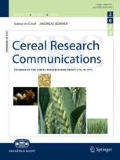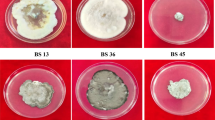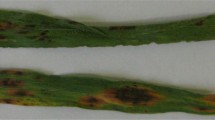Abstract
In a survey of barley leaf spot diseases across East Azerbaijan province in Iran, barley plants with brown leaf spot, were collected from barley fields in the Spiran region, the central district of Tabriz County, East Azerbaijan Province, Iran. The disease incidence was 30 percent in sampled areas. Fungal colonies with similar growth pattern were isolated from symptomatic leaves. The isolates were characterized based on a combination of morphological data and sequence data of ITS-rDNA region as P. semeniperda. Pathogenicity assay was fulfilled using the seed infection method under greenhouse conditions. Correspondingly, P. semeniperda stromata were developed on 90% of intact and 95% of scarifies barley seeds and they failed to germinate. Koch’s postulates were fulfilled by re-isolation of the causal agent from inoculated seeds. To the best of our knowledge, P. semeniperda represents a new pathogen on barley in Iran. However, geographical distribution, host range and economic impact of this pathogen on major barley producing areas in Iran remain to be studied.



Similar content being viewed by others
References
Ariyawansa HA, Kang JC, Alias SA, Chukeatirote E, Hyde KD (2014) Pyrenophora. Mycosphere 5(2):351–362
Bair NB, Meyer SE, Allen PS (2006) A hydrothermal after-ripening time model for seed dormancy loss in Bromus tectorum L. Seed Sci Res 16:17–28
Barreto D, Fortugno C (1994) Drechslera verticillata: cereal pathogen. INTA Argent 25:71–79
Barth CW, Meyer SE, Beckstead J, Allen PS (2015) Hydrothermal time models for conidial germination and mycelial growth of the seed pathogen Pyrenophora semeniperda. Fungal biol 119:720–730
Bauer MC, Meyer SE, Allen PS (1998) A simulation model to predict seed dormancy loss in the field for Bromus tectorum L. J Exp Bot 49:1235–1244
Beckstead J, Meyer SE, Ishizuka TS, McEvoy KM, Coleman CE (2016) Lack of host specialization on winter annual grasses in the fungal seed bank pathogen Pyrenophora semeniperda. PLoS ONE 11(3):e0151058
Beckstead J, Meyer SE, Molder CJ, Smith C (2007) A race for survival: can bromus tectorum seeds escape Pyrenophora semeniperda-caused mortality by germinating quickly? Ann Bot 99:907–914
Beckstead J, Meyer SE, Reinhart KO, Bergen KM, Holden SR, Boekweg HF (2014) Factors affecting host range in a generalistseed pathogen of semi-arid shrublands. Plant Ecol 215:427–440
Boose D, Harrison S, Clement S, Meyer SE (2011) Population genetic structure of the seed pathogen Pyrenophora semeniperda on Bromus tectorum in western North America. Mycologia 103:85–93
Campbell MA, Medd RW, Brown JF (1996) Cultural and infection studies on Pyrenophora semeniperda: a possible bioherbicide for annual grass weeds. In: Proceedings of the IX international symposium on biological control of weeds. (Eds VC Moran, JH Hoffmann) pp 519–523. (University of Cape Town: Cape Town, South Africa)
Campbell MA, Medd RW (2003) Leaf, floret and seed infection of wheat by Pyrenophora semeniperda. Plant Pathol 52:437–447
Christensen M, Meyer SE, Allen PS (1996) A hydrothermal time model of seed after-ripening in Bromus tectorum L. Seed Sci Res 6:155–163
Ehlert KA, Mangold JM, Engel RE (2014) Integrating the herbicide imazapic and the fungal pathogen Pyrenophora semeniperda to control Bromus tectorum. Weed Res 54:418–424
Farr DF, Rossman AY (2020) Fungal Databases, U.S. National Fungus Collections, ARS, USDA. Retrieved September 28, 2020, from https://nt.ars-grin.gov/fungaldatabases/
McDonald BA, Zhan J, Burdon JJ (1999) Genetic structure of Rhynchosporium secalis in Australia. Phytopathology 89:639–645
Medd RW (1992) A review of the world distribution and host range of Pyrenophora semeniperda (Brittlebank & Adam) Shoemaker. Rev Plant Pathol 71:891–901
Medd RW, Jones KH (1992) Host range, distribution and importance of the fungus Pyrenophora semeniperda (Brittlebank & Adam) Shoemaker (Ascomycotina: Pyrenomycetes) in Australia. Proc Linnean Soc NSW 113:15–26
Medd RW, Murray GM, Pickering DI (2003) Review of the epidemiology and importance of Pyrenophora semeniperda. Aus Plant Pathol 32:539–550
Meyer SE, Merrill KT, Allen PS, Beckstead J, Norte AS (2014) Indirect effects of an invasive annual grass on seed fates of two native perennial grass species. Oecologia 174:1401–1413
Meyer SE, Allen PS (2009) Predicting seed dormancy loss and germination timing for Bromus tectorum in a semi-arid environment using hydrothermal time models. Seed Sci Res 19:225–239
Meyer SE, Beckstead J, Allen PS, Smith DC (2008) A seed bank pathogen causes seedborne disease: Pyrenophora semeniperda on undispersed grass seeds in western North America. Can J Plant Pathol 30:525–533
Moller EM, Bahnweg G, Geiger HH (1992) A simple and efficient protocol for isolation of high molecular weight DNA from filamentous fungi, fruit bodies, and infected plant tissues. Nucl Acids Res 20:6115–6116
Nylander JAA (2004) MrModeltest v2. Evolutionary Biology Centre, Uppsala University, Program distributed by the author
Ronquist F, Huelsenbeck JP (2003) MRBAYES 3: Bayesian phylogenetic inference under mixed models. Bioinformatics 19:1572–1574
Stewart TE, Allen PS, Meyer SE (2009) First report of Pyrenophora semeniperda in Turkey and Greece. Plant Dis 93:1351
Walters DR, Avrova A, Bingham IJ, Burnett FJ, Fountaine J, Havis ND, Hoad SP, Hughes G, Looseley M, Oxley SJP, Renwick A, Topp CFE, Newton AC (2012) Control of foliar diseases in barley: towards an integrated approach. Eur J Plant Pathol 133:33–73
White TJ, Bruns T, Lee S, Taylor J (1990) Amplification and direct sequencing of fungal ribosomal RNA genes for phylogenetics. In: Innis MA, Gelfand DH, Sninsky JJ, White TJ (eds) A guide to methods and applications. Academic, San Diego (CA), pp 315–322
Yonow T, Kriticos DJ, Medd RW (2004) The potential geographic range of Pyrenophora semeniperda. Phytopathology 94:805–812
Zhang G, Berbee ML (2001) Pyrenophora phylogenetics inferred from ITS and glyceradehyde-3-phosphate dehydrogenase gene sequences. Mycologia 93(6):1048–1063
Acknowledgements
Vice-chancellor for Research and Technology of University of Tabriz is kindly acknowledged.
Funding
This work was financially supported by University of Tabriz and Iran’s National Elite Foundation.
Author information
Authors and Affiliations
Corresponding author
Ethics declarations
Conflict of interest
The authors declare that they have no conflict of interest.
Human and animals’ rights
No human and/or animal participants were involved in this research.
Informed consent
All authors consent to this submission.
Rights and permissions
About this article
Cite this article
Dokhanchi, H., Arzanlou, M. & Abed-Ashtiani, F. First occurrence of Pyrenophora semeniperda a new pathogen on barley in Iran. CEREAL RESEARCH COMMUNICATIONS 50, 59–66 (2022). https://doi.org/10.1007/s42976-021-00149-x
Received:
Accepted:
Published:
Issue Date:
DOI: https://doi.org/10.1007/s42976-021-00149-x




